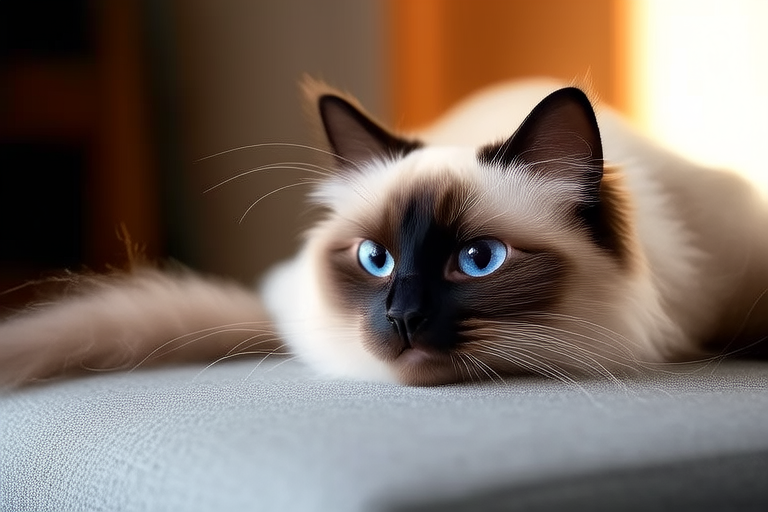Unveiling the Secrets Behind the Lethargic Grace of Ragdolls
Ragdolls are one of the most beloved cat breeds due to their gentle disposition and affectionate nature. Known for their docile demeanor and tendency to go limp when held, these felines have captured the hearts of many cat enthusiasts. This article delves into the fascinating world of Ragdolls, exploring their history, unique physical traits, behavior patterns, and the genetic factors that contribute to their laid-back personalities. Additionally, we will provide essential tips for caring for a Ragdoll cat, ensuring that both new and experienced owners can appreciate and nurture these charming creatures.
The History of Ragdolls
The origin of the Ragdoll breed dates back to the mid-20th century in California. Ann Baker, a breeder from Riverside, developed the Ragdoll by selectively breeding her own cat, Josephine, with other domestic shorthair cats. Josephine had a unique trait where she would go limp when picked up, which became a hallmark characteristic of the Ragdoll breed. Baker’s breeding program led to the creation of a distinct breed recognized for its striking blue eyes, silky coat, and docile temperament.
Initially, the Ragdoll was a relatively unknown breed outside of Baker’s community. However, after some time, other breeders took interest in the breed and began to establish it as a recognized breed. The International Cat Association (TICA) was the first to recognize the Ragdoll in 1965, followed by the Cat Fanciers’ Association (CFA) in 1994. Today, Ragdolls are one of the most popular cat breeds worldwide, cherished for their friendly and relaxed nature.
Physical Traits of Ragdolls
Ragdolls are large, semi-longhaired cats known for their striking appearance. They typically weigh between 10 to 20 pounds, making them one of the larger domestic cat breeds. Their muscular bodies are complemented by a broad chest and a sturdy build, giving them an elegant yet robust look.
Their most distinctive feature is their plush, semi-long coat, which requires regular grooming to prevent matting. Ragdolls come in various colors and patterns, including seal, chocolate, and blue point, among others. One of the most recognizable features of Ragdolls is their deep blue eyes, which add to their serene and gentle expression.
In addition to their striking appearance, Ragdolls possess a unique trait that sets them apart from other cat breeds. When picked up, they tend to become completely relaxed, going limp like a rag doll, hence the name. This behavior is often attributed to their genetics and is one of the reasons why Ragdolls are such affectionate pets.
Temperament and Behavior
Ragdolls are renowned for their docile and affectionate nature. They are highly social animals that enjoy being around people and other pets. Ragdolls are known to follow their owners around the house, seeking attention and companionship. They are particularly fond of being petted and held, often purring contentedly while receiving affection.
Despite their calm demeanor, Ragdolls are not entirely inactive. They engage in playful activities, especially during their younger years. Ragdolls enjoy interactive toys and games that stimulate their curiosity and intelligence. However, as they age, their activity levels tend to decrease, and they become more content with lounging around the house.
One of the most endearing qualities of Ragdolls is their loyalty and bond with their owners. They are often described as “dog-like” in their devotion and responsiveness. Ragdolls are known to greet their owners at the door and may even learn to walk on a leash, further emphasizing their unique and adaptable nature.
Genetics and Docile Nature
The docile and affectionate nature of Ragdolls is largely attributed to their genetics. While the exact genetic mechanisms behind their relaxed demeanor are not fully understood, researchers have identified several factors that contribute to their calm and easygoing personalities.
One theory suggests that the Ragdoll’s docile nature may be linked to a recessive gene that affects their nervous system. This gene may cause Ragdolls to experience a temporary paralysis when they are excited or stressed, leading to their characteristic limpness when held. However, this theory remains speculative, and further research is needed to confirm the genetic basis of their laid-back behavior.
Another factor that contributes to the Ragdoll’s docile nature is their selective breeding history. Over generations, breeders have focused on selecting cats with calm and affectionate temperaments, reinforcing these traits through careful breeding practices. This selective breeding has resulted in a breed that is naturally predisposed to being gentle and loving.
Caring for a Ragdoll Cat
Owning a Ragdoll cat is a rewarding experience, but it also comes with responsibilities. Proper care and maintenance are essential to ensure that your Ragdoll remains healthy and happy. Here are some tips for caring for a Ragdoll cat:
- Grooming: Ragdolls have a semi-long coat that requires regular brushing to prevent matting and tangles. Brush your Ragdoll at least twice a week to keep their coat in top condition.
- Diet: Provide your Ragdoll with a balanced diet rich in proteins and nutrients. Consult with your veterinarian to determine the appropriate diet based on your cat’s age, weight, and activity level.
- Exercise: Encourage your Ragdoll to stay active by providing them with interactive toys and playtime. Regular exercise helps maintain their physical and mental health.
- Veterinary Care: Schedule routine veterinary check-ups and vaccinations to ensure your Ragdoll remains healthy. Be proactive about addressing any health concerns and maintain a clean living environment.
- Attention: Ragdolls thrive on attention and companionship. Spend quality time with your Ragdoll, offering them affection and interaction to strengthen your bond.
Conclusion
Ragdolls are truly unique and special cats that bring joy and companionship to their owners. Their gentle disposition, striking appearance, and affectionate nature make them a favorite among cat lovers. Understanding the history, physical traits, behavior patterns, and genetic factors behind their laid-back demeanor provides insight into what makes Ragdolls so special. By following proper care guidelines, you can ensure that your Ragdoll remains healthy and happy, creating a lifelong bond with your furry friend.
